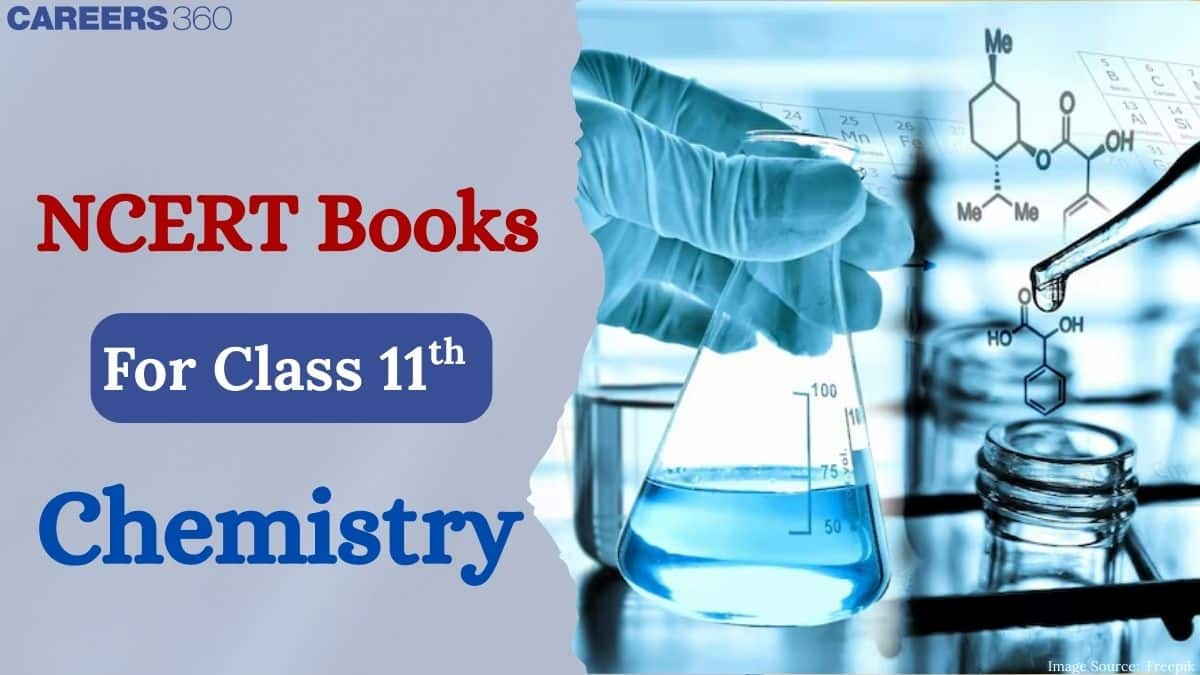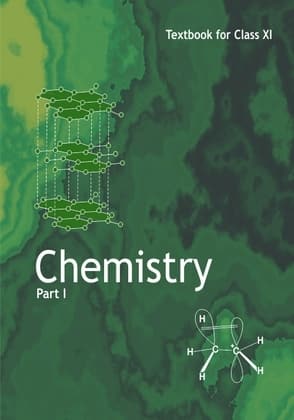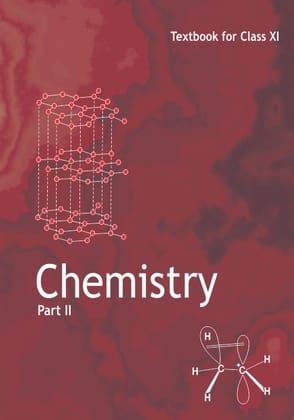NCERT Books for Class 11 Chemistry 2026 – Download Free PDF
Chemistry is one of the important subjects for Science students. The NCERT Class 11 Chemistry book is written in a very simple and comprehensive way, and students can download this Chemistry Book from the official website of NCERT. This Chemistry textbook introduces students to the foundational concepts like chemical bonding, atomic structure, Thermodynamics, Equilibrium and an introduction to organic chemistry. NCERT Books for Class 11 are important not only for CBSE and other state board exams but also for competitive exams. NCERT Books are written in a systematic way that includes explanations, diagrams and questions for practice. To perform well in exams, students should refer to NCERT solutions, designed by our subject experts in a very comprehensive and systematic way. In this article, students are going to learn about the topics and chapters covered in the Class 11 Chemistry NCERT Book 2026. Scroll down to learn more.
This Story also Contains
- Download NCERT Book for Class 11 Chemistry PDF 2026
- NCERT Books of Class 11 Chemistry 2026 Chapter-wise Links
- How to Download Free NCERT Class 11 Chemistry Textbook PDF 2026?
- How to Prepare for Exam Using the NCERT Book for Class 11 Chemistry 2026?
- NCERT Solutions For Class 11 Chemistry 2026
- Best Reference Books for Class 11 Chemistry 2026

Download NCERT Book for Class 11 Chemistry PDF 2026
The Class 11 Chemistry book helps students build a strong base for higher studies and competitive exams. Download the NCERT Class 11 Chemistry Book PDF from the links given below. These books are aligned with the updated CBSE syllabus for both school exams and competitive exams.
| Book title | Download link |
|---|---|
| NCERT 11th Chemistry Book - Part 1 | Click here |
| NCERT 11th Chemistry Book - Part 2 | Click here |
NCERT Books of Class 11 Chemistry 2026 Chapter-wise Links
Download the NCERT Class 11 Chemistry Book PDF, designed as per the latest CBSE curriculum. These books are available in a chapter-wise PDF format to help students study systematically and efficiently. Here you will find chapter-wise links that students can easily download each chapter separately. This makes revision simple.
How to Download Free NCERT Class 11 Chemistry Textbook PDF 2026?
Download NCERT Class 11 Chemistry Book 2026 PDF, by following the steps given below. These Books are officially released by NCERT and can be easily downloaded in PDF format.
- Go to the official website of NCERT, i.e, ncert.nic.in
- Search "Textbook" in the search bar on the upper right-hand side of the site.
- "Textbooks PDF (I-XII)" will show up. Click on this.
- In the "Select class" dropdown, choose ' Class XI' and in the "Select Subject" drop-down select 'Chemistry'.
- Now, you are supposed to choose the name of the book.
- Click on the “Go” button.
- A list of chapters will appear, and you can download the individual chapters in PDF format.
- Click on the chapter-wise links and download the NCERT Books for Class 11 Chemistry 2026 PDF for each chapter separately
- Once downloaded, you can access the textbook offline anytime for easy reference and study
NCERT Books for Class 11 Chemistry Part 1 Cover Page

NCERT Books for Class 11 Chemistry Part 2 Cover Page

Also read -
How to Prepare for Exam Using the NCERT Book for Class 11 Chemistry 2026?
NCERT Class 11 chemistry book is the best source to develop a strong basis and score good marks in exams. This book is very helpful in preparing for boards and competitive exams like JEE, NEET, etc.
- To understand the concepts better, students must read every chapter thoroughly.
- It is very important to make short notes of key formulas, reactions, and definitions as they will be very helpful for exam times.
- Questions from the NCERT Books are often asked in the exam. So it is very important to solve all in-text and end-of-chapter questions to test your understanding.
- Revise topics regularly to keep concepts fresh in your mind.
NCERT Solutions For Class 11 Chemistry 2026
Below are links to access solutions for all chapters from the NCERT Books for Class 11 Chemistry, designed to help you strengthen your understanding of key concepts. These solutions are aligned with the latest syllabus.
Best Reference Books for Class 11 Chemistry 2026
Students can follow the books given below for the CBSE boards and competitive exams
- NCERT Chemistry Class 11 Part 1 & Part 2
- S. Chand’s Chemistry by Lakhmir Singh & Manjit Kaur
- Pradeep’s New Course Chemistry
- Modern ABC of Chemistry
For Competitive Exams (JEE/NEET)
| Physical Chemistry | Organic Chemistry | Inorganic Chemistry |
|---|---|---|
| Physical Chemistry by O.P. Tandon | Organic Chemistry by O.P. Tandon | Concise Inorganic Chemistry by J.D. Lee |
| Physical Chemistry by R.C. Mukherjee (for numericals) | Organic Chemistry by M.S. Chouhan (JEE-focused problems) | VK Jaiswal for practice questions (JEE-focused) |
NCERT Books for Class 11 Subject Wise
Students can access other NCERT books here by clicking on the links provided below:
Frequently Asked Questions (FAQs)
Yes, you can purchase printed copies of the NCERT Class 11 Chemistry book from bookstores or educational supply centers.
The NCERT Books for Class 11 Chemistry 2026 are a comprehensive educational resource designed by the National Council of Educational Research and Training for students in India. It covers the fundamental concepts of chemistry as per the curriculum prescribed for Class 11.
You can Download NCERT Class 11 Chemistry Book 2026 PDF from the official NCERT website. They provide the NCERT Class 11 Chemistry Book PDF, which can be easily accessed and downloaded without any cost.
The NCERT Books for Class 11 Chemistry 2026 covers a range of topics, including basic concepts of chemistry, structure of atoms, classification of elements and periodicity in properties, chemical bonding, and thermodynamics etc.
For class 11 chemistry, NCERT publishes two books named Part 1 and Part 2
Yes, the NCERT Class 11 Chemistry PDF can be accessed and downloaded on various devices, including mobile phones, tablets, and computers.
The NCERT Chemistry book for Class 11 is highly recommended because it aligns with the CBSE syllabus. It simplifies complex concepts, includes diagrams, examples, and exercises that help reinforce learning. Additionally, most competitive exams in India, like JEE.
Yes, the PDF version of the NCERT Chemistry book for Class 11 is available for free download. NCERT provides these resources online to ensure that all students have access to quality educational materials.
Yes, there are several resources available online that provide solutions to the exercises and questions presented in the NCERT Class 11 Chemistry book.
NCERT Chemistry books provide a solid foundation in fundamental concepts, which is crucial for competitive exams like JEE and NEET. The clarity of explanations and the variety of questions available in the NCERT books help build a strong conceptual understanding.
Popular Questions
Courses After 12th
Applications for Admissions are open.
As per latest syllabus. Physics formulas, equations, & laws of class 11 & 12th chapters
JEE Main Important Chemistry formulas
Get nowAs per latest syllabus. Chemistry formulas, equations, & laws of class 11 & 12th chapters
JEE Main high scoring chapters and topics
Get nowAs per latest 2024 syllabus. Study 40% syllabus and score upto 100% marks in JEE
JEE Main Important Mathematics Formulas
Get nowAs per latest syllabus. Maths formulas, equations, & theorems of class 11 & 12th chapters
